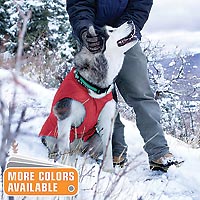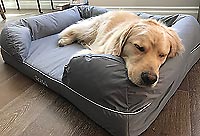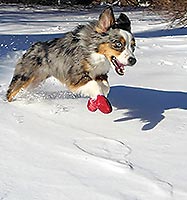Does your dog love the winter or would they rather cuddle up on the couch under a cozy blanket? Either way, you should be prepared to protect them when they venture out into the elements. Winter care tips for your dog are important to keep them safe this season. Many dog owners live with the misconception that because their pets have a coat of fur, they can tolerate the cold better than humans. This isn’t necessarily the case. Like us, these fur-coated creatures are used to the warmth of indoor shelter and cold weather can be as hard on them as it is on us humans. Whatever your viewpoint on winter, one thing remains certain: it’s a time when our beloved pets need a little extra care.
 Beware of cold temperatures Beware of cold temperatures
While many dogs can be safe down to 20 degrees with proper shelter; puppies, smaller and older dogs should not be left outdoors when the temperature falls below 40 degrees. Shorthaired dogs, such as Dachshunds or Greyhounds, can become immediately chilled upon leaving the warm house, so they will need a sweater put on before going outside. I know not everyone agrees with dressing dogs but keep in mind you are not “playing dress-up” with your dog but rather providing them an extra layer of protection against the cold.
Watch for signs of frostbite, injury and hypothermia
Dog’s ears, paws and tails are very susceptible to frostbite. Initially frostbitten tissue may appear pale or grey in color and the area will be cold and hard to the touch. In severe frostbite cases, within several days the tissue will begin to appear black. If you suspect frostbite contact a veterinarian. If your dog plays on ice or hard frozen dirt their paws are susceptible to cuts as they slide across these surfaces, so always wipe their feet after a walk to remove snow, dirt and salt deposits used to remove snow from sidewalks or driveways. Paw protection can also be achieved utilizing booties, paw covers and paw wax. Salt irritates the dog’s paws and can be toxic if ingested – use only pet-safe ice melt. Your dog may be experiencing hypothermia if you notice shivering, lethargy, low heart rate and unresponsiveness. If you notice these symptoms bring your dog into a warm area, place a light blanket over them, and call your vet immediately.
Provide cozy bedding
In addition to limiting your dog’s time outdoors on cold days, don’t let your pooch sleep on a cold floor in winter. Choosing the right bedding is vital to ensure your dog stays warm. Warm blankets can create a snug environment; raised beds can keep your dog off cold tiles or concrete, and heated pet beds can help keep the stiffness out of aging joints. Place your dog’s bed in a warm spot away from drafts, cold tile or uncarpeted floors, preferably in a favorite spot where they sleep every day so that the area doesn’t feel unfamiliar.
Protect your dog from heaters
Dogs will often seek heat during cold winter weather by snuggling too close to heating sources. Avoid space heaters and install baseboard radiator covers to avoid your pet getting burned. Fireplaces also pose a major threat so please make sure you have a pet proof system to keep your heat-seeking pal out of harm’s way.
Eliminate the possibility of poisoning
Unfortunately dogs like the sweet taste of antifreeze which can cause sickness or death if ingested. Make certain that all antifreeze is well out of reach of dogs and clean any spills immediately. During the holiday season be sure to keep poisonous plants like poinsettias, holly and mistletoe out of reach, if ingested these can cause vomiting, diarrhea and nausea. It is also very important to keep human holiday treats like alcohol and chocolate out of reach as well as they are toxic to dogs
Provide a protective shelter
If your dog stays outside much of the time in winter, make certain that their doghouse meets certain minimum criteria. It needs to be raised a couple of inches off the frozen ground or concrete, the inside needs to have a blanket that is covering straw, which should be changed frequently to keep them warm and dry. The size of the doghouse should be large enough so your dog can sit and stand, but small enough that their body heat will be retained in the house. If your dog stays in the garage make sure you have them leave before you start your car and run it to warm it up as this can cause your dog to be exposed to excess levels of carbon monoxide from your vehicles exhaust.
Supply fresh water and provide an appropriate amount of food
Use a plastic water bowl to ensure that your dog’s tongue does not stick to a metal bowl. Change the water often to stop it from freezing or consider getting a heated water bowl that will also stop it from freezing. If your dog remains active in winter, they will burn more calories in the cold and will need about 10% more food to compensate. If your dog becomes less active in the winter, try to keep them from gaining extra weight by cutting back their food and making sure you continue taking them for walks and playing with them.
Moisturize
Dry and cold weather can do a number on your pet’s skin. Help prevent dry, flaky skin by adding a skin and coat supplement to their food. Coconut oil is a good natural moisturizer that can help keep your pet’s skin and coat healthy. If you find your dogs paws, ears or tail are dry or cracking, you can also apply coconut oil topically as needed.
Exercise
Shorter, more frequent walks will keep both of you warmer than one long walk during the worst of the winter weather. Train your dog not to pull and drag you on the leash, quite often injuries happen to people walking their dog in the winter not because they slip on ice but because they trip over their dog. Also if your dog walks calmly next to you they are also less likely to slip and fall. If you do not feel safe to exercise outside find another way to exercise your dog. Some people have trained their dogs to walk on a treadmill, alternatively find a doggie daycare facility that has an indoor facility so your dog can play and socialize with other dogs, this will provide them with exercise and combat boredom that often manifests as destructive behavior. Turning your dog out to play in the yard unsupervised is not providing exercise, most likely the dog will sit by the door waiting to come back inside where it is warm!
Never leave your dog in the car
Just as cars can get dangerously hot in summer, freezing cold temperatures are equally dangerous for your dog in winter. Leaving the car running involves additional risks, including carbon monoxide poisoning if the car is parked in a garage. Leave your dog at home when you go out to run errands.
Special care for seniors
Cold weather will often aggravate existing medical conditions in dogs, particularly arthritis. It’s very important to maintain an exercise regimen with your arthritic dog, but be mindful of slippery surfaces and make sure your dog has a warm soft rest area to recuperate after activity. If you don’t already give your senior dog a natural joint supplement to lubricate the joints and ease the discomfort of arthritis, you may want to consider adding one in winter. Just like people, dogs are more susceptible to other illnesses during winter weather.
Harsh winter weather brings a wide variety of concerns to responsible dog owners. Bitter cold, numbing wetness or biting winds can cause discomfort for that special dog in your life. Paying special attention to your loyal friend’s wellbeing during the winter season will ensure that you both enjoy the season to the fullest.
Winterizing your dog is something all dog owners need to think about to protect them during the cold winter months. If you have any concerns or questions about how to help your pet contact your veterinarian, however, the rule of thumb is to put yourself in your dog’s environment and build from there to make it a safe and comfortable winter season for your pooch. Keep these winter care tips in mind and enjoy everything winter has to offer. And don’t forget that winter cuddles with your canine buddy are a great way for everybody to keep warm.
|